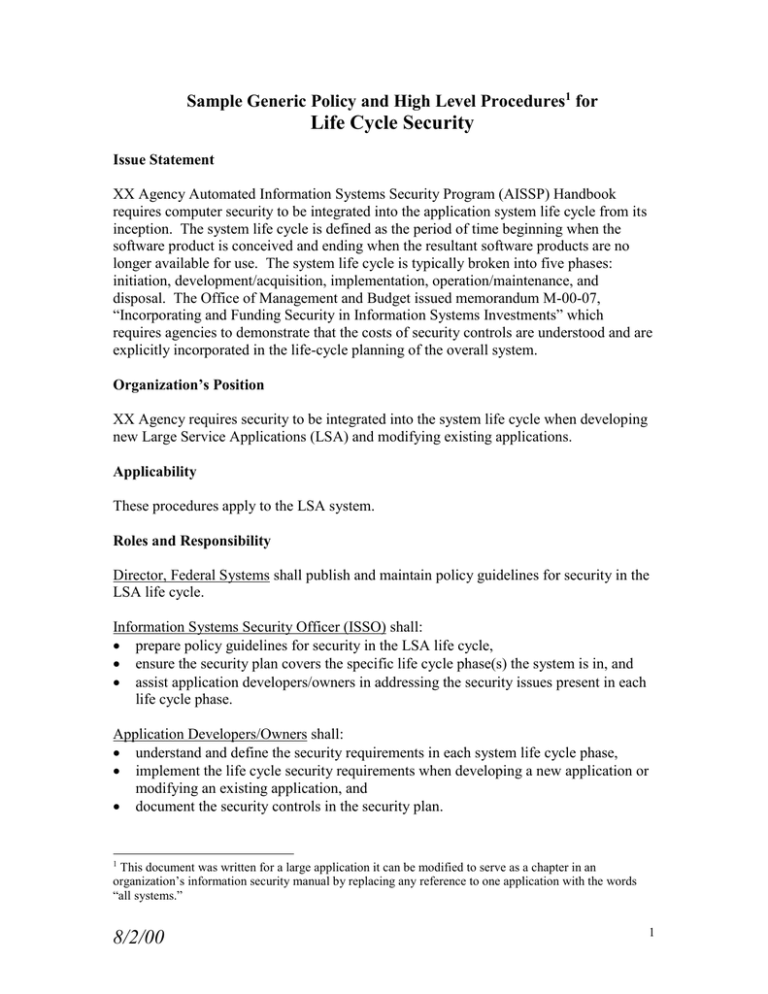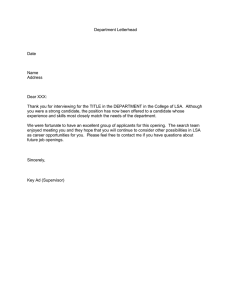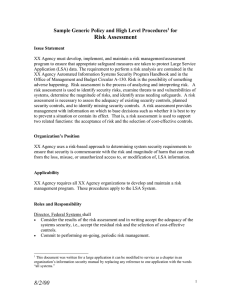Life Cycle Security Sample Generic Policy and High Level Procedures for
advertisement

Sample Generic Policy and High Level Procedures1 for Life Cycle Security Issue Statement XX Agency Automated Information Systems Security Program (AISSP) Handbook requires computer security to be integrated into the application system life cycle from its inception. The system life cycle is defined as the period of time beginning when the software product is conceived and ending when the resultant software products are no longer available for use. The system life cycle is typically broken into five phases: initiation, development/acquisition, implementation, operation/maintenance, and disposal. The Office of Management and Budget issued memorandum M-00-07, “Incorporating and Funding Security in Information Systems Investments” which requires agencies to demonstrate that the costs of security controls are understood and are explicitly incorporated in the life-cycle planning of the overall system. Organization’s Position XX Agency requires security to be integrated into the system life cycle when developing new Large Service Applications (LSA) and modifying existing applications. Applicability These procedures apply to the LSA system. Roles and Responsibility Director, Federal Systems shall publish and maintain policy guidelines for security in the LSA life cycle. Information Systems Security Officer (ISSO) shall: prepare policy guidelines for security in the LSA life cycle, ensure the security plan covers the specific life cycle phase(s) the system is in, and assist application developers/owners in addressing the security issues present in each life cycle phase. Application Developers/Owners shall: understand and define the security requirements in each system life cycle phase, implement the life cycle security requirements when developing a new application or modifying an existing application, and document the security controls in the security plan. 1 This document was written for a large application it can be modified to serve as a chapter in an organization’s information security manual by replacing any reference to one application with the words “all systems.” 8/2/00 1 Life Cycle Security Policy In each phase of the system life cycle there are specific computer security requirements that should be met. Listed below is a synopsis of the security activities that should be performed. For more detail on how to perform the activities, see NIST Special Publication 800-12, "An Introduction to Computer Security: The NIST “Handbook," Chapter 8. Life Cycle Security. Initiation Phase A sensitivity assessment shall be conducted which looks at the criticality of the information processed and the system itself. The assessment shall consider which laws, regulations or policies establish specific requirements for the availability, integrity, and confidentiality of the system. The environmental (e.g., hazardous location) and public threats to the system or information should also be considered. Development/Acquisition Phase Security requirements shall be developed at the same time system planners define the requirements of the system. The security requirements shall be incorporated into design specifications along with assurances that the security features acquired can and do work correctly and effectively. Implementation Phase The system's security features shall be configured and enabled. The system shall be tested and installed or fielded and the system authorized for processing. Operation/Maintenance Phase Complete the many security activities outlined in the various rules of the system. Perform backups, hold training classes, password management, review the system are just some examples. Disposal Phase Information may be moved to another system, archived, discarded or destroyed. Hardware and software can be sold, given away or discarded. There is rarely a need to destroy hardware accept for some storage media containing confidential information that cannot be sanitized without destruction. The disposition of software needs to be in keeping with its license or other agreements. Compliance The requirement to address computer security in the system life cycle is contained in the XX Agency Automated Information Systems Security Program Handbook. 8/2/00 2 Supplementary Information NIST Automated Information Systems Security Program Handbook, May 1994 NIST Special Publication 800-12, "An Introduction to Computer Security: The NIST Handbook," Chapter 8. Life Cycle Security Office of Management and Budget Memorandum M-00-07, “Incorporating and Funding Security in Information Systems Investments,” February 28, 2000 Points of Contact Information Systems Security Officer 8/2/00 LSA Security Officer – XX Agency Site 3



